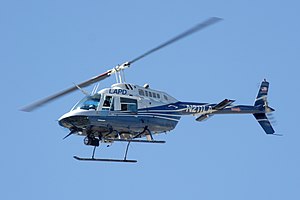This article needs additional citations for verification. (December 2023) |




A helicopter is a type of rotorcraft in which lift and thrust are supplied by horizontally spinning rotors. This allows the helicopter to take off and land vertically, to hover, and to fly forward, backward and laterally. These attributes allow helicopters to be used in congested or isolated areas where fixed-wing aircraft and many forms of short take-off and landing (STOL) or short take-off and vertical landing (STOVL) aircraft cannot perform without a runway.
In 1942, the Sikorsky R-4 became the first helicopter to reach full-scale production.[1][2]
Although most earlier designs used more than one main rotor, the configuration of a single main rotor accompanied by a vertical anti-torque tail rotor (i.e. unicopter, not to be confused with the single-blade monocopter) has become the most common helicopter configuration. However, twin-rotor helicopters (bicopters), in either tandem or transverse rotors configurations, are sometimes in use due to their greater payload capacity than the monorotor design, and coaxial-rotor, tiltrotor and compound helicopters are also all flying today. Four-rotor helicopters (quadcopters) were pioneered as early as 1907 in France, and along with other types of multicopters, have been developed mainly for specialized applications such as commercial unmanned aerial vehicles (drones) due to the rapid expansion of drone racing and aerial photography markets in the early 21st century, as well as recently weaponized utilities such as artillery spotting, aerial bombing and suicide attacks.
- ^ Munson 1968.
- ^ Hirschberg, Michael J. and David K. Dailey, "Sikorsky" Archived 18 December 2007 at the Wayback Machine. US and Russian Helicopter Development in the 20th Century, American Helicopter Society, International. 7 July 2000.